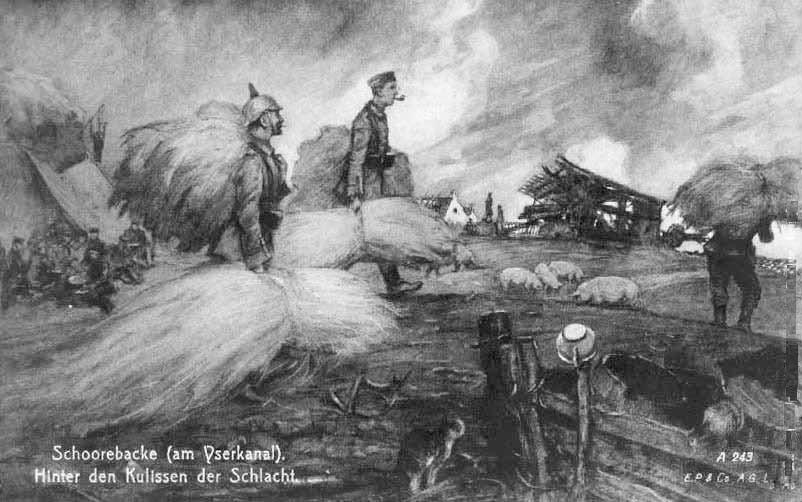
World War II German Homefront: Hitler's Food Vision: The East

Figure 1.--Germany since the Medieval era has had an almost mystical vision of the East--Der Drag nach Osten. This was revived in the 19th century as Germany industrialized. And it need food to feed workers and raw materials to supply factories. Geo-strategist began to depict Germany's future in the East. Karl Ernst Haushofer (1869–1946) influenced Hitler's thinking as one can see in 'Mein Kampf'. The idea of seizing the East appealed to Hitler despite the fact that the theory did not work out in practice. Despite seizing large areas of the Eas during World War I, Germany was unable to feed its people and the decision to wage a two front war was a major reason for Germany's defeat. Even after victory in the East (1917), the need to maintain a large army there to garison the region and to prevent diversion of food shipments meant that only a part of its eastern army could be moved West for their great Spring offensive (1918). Even so, Hitler decided to pursue the same failed strategy. And it worked even worse in World War II. The food the Wehrmacht seized in the Eastm barely covered the food needs of the forces deployed there. As in World war I, very little food was shipped home to the Reich. Yhe food that fed the Germans during World War II primarily came from France and other occupied countries in the Wast. This German Eorld War I post card shows German troops looting behind the front lines. "Schoorebacke (am Pserkanal). Hinter den Kulissen der Schlacht" translates as "Schoorebacke (at the Pserkanal). Behind the scene of the battle." Creating a postcard depicting looting is illuminating. We don't recall ever seeing looting being depicted in Allied postcards.
|
|
Hitler unlike the Kaiser managed to keep the German reasonably well fed until the last year of the War. He did this by looting occupied countries where in the East people were essentially left to starve. The first food crisis occurred un Greece (1941) in the run up to Barbarossa. Hitler explained more than a decade before the War that the answer to Germany's problems lay in the East. And Hitler made no secret about it from the very beginning. He wrote, "... we National Socialists must hold unflinchingly to our aim in foreign policy, namely, to secure for the German people the land and soil to which they are entitled on this earth. And this action is the only one which, before God and our German posterity, would make any sacrifice of blood seem justified: before God, since we have been put on this earth with the mission of eternal struggle for our daily bread, beings who receive nothing as a gift, and who owe their position as lords of the earth only to the genius and the courage with which they can conquer and defend it; and before our German posterity in so far as we have shed no citizen's blood out of which a thousand others are not bequeathed to posterity. The soil on which some day German generations of peasants can beget powerful sons will sanction the investment of the sons of today, and will some day acquit the responsible statesmen of blood-guilt and sacrifice of the people, even if they are persecuted by their contemporaries." [Hitler, Mein Kampf: Volume One - A Reckoning, Chapter XIV: Eastern Orientation or Eastern Policy] And he intriduced aacial element. And he made this even clearer in his second book which he had second thoughts about publihing because he was even more frank. The idea of Lebensraum was central to his thinking. He believed that an Eastern European empire was essential which meant war and conquest. He rejected the idea that agricultural technology could resolve Germany's food problem. In Hitler’s “Second Book,” which was composed in 1928 and not published until after the War. He wote that hunger would outstrip crop improvements and that “the scientific methods of land management” had already failed. He was convinced that no conceivable scientific advances would allow Germany to become self sufficent in food. Hitler, Second Book.] The very idea that peace and plenty could be achived through science he charged was just one more Jewish plot, esigned to distract Germans from the necessity of war. “It is always the Jew who seeks and succeeds in implanting such lethal ways of thinking.” [Hitler, Mein Kampf.] And thus as the war developed, the sollution to feeding the Reich was in part just as Hitler had envisioned--seizing territory in the East and the agricultural production that went with it. Only contrary to his expectaions, the food did not come from the East--except Poland. The German conquests in the East with Brbarossa barely managed to feed the huge German and allied Axis forces deployed there. Very little was left over to feed the Reich. The food feeding the reich mostly came from conquests in the West, especially France. One researcher estimates that some 40 percent of the bread and meat eaten by the Wehrmacht and civilians was harvested and produced in the occupied territories or by workers deported from these countries along with POWs to replace conscripted German agricultural workers. [Collingham]
Sources
CIH -- WW II

Navigate the CIH World War II Section:
[Return to Main German World War II food page]
[Return to Main German World War II weaknesses page]
[Return to Main German World War II play page]
[Return to Main German World War II home front page]
[Return to Main World War II displaced children page]
[About Us]
[Biographies]
[Campaigns]
[Children]
[Countries]
[Deciding factors]
[Diplomacy]
[Geo-political crisis]
[Economics]
[Home front]
[Intelligence]
[POWs]
[Resistance]
[Race]
[Refugees]
[Technology]
[Totalitarian powers]
[Bibliographies]
[Contributions]
[FAQs]
[Images]
[Links]
[Registration]
[Tools]
[Return to Main World War II page]
[Return to Main war essay page]
[Return to CIH Home page]
Created: 7:01 PM 8/24/2007
Last updated: 3:26 PM 3/8/2016



